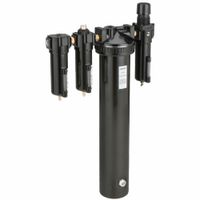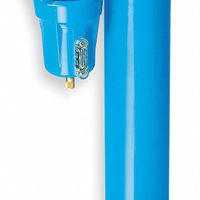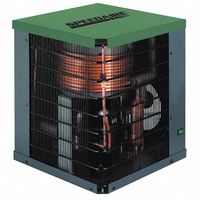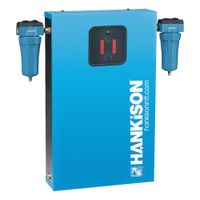Call +(254) 703 030 000 / 751 483 999 / 721 704 777
- Home
- Pneumatics
- Compressed Air Treatment
- Compressed Air Dryers
.....Read More
Frequently Asked Questions
What is the purpose of a dryer in a compressed air system?
The purpose of a dryer in a compressed air system is to remove moisture from the air. When air is compressed, its temperature increases, and as it cools, the moisture it contains condenses into liquid water. This moisture can cause several issues, such as corrosion, equipment damage, and reduced efficiency in pneumatic systems.
A dryer ensures that the compressed air is dry before it reaches the end-use equipment. There are several types of dryers used in compressed air systems:
1. **Refrigerated Dryers**: These cool the air to condense moisture, which is then removed. They are suitable for general-purpose applications where dew points around 35-50°F (1.5-10°C) are acceptable.
2. **Desiccant Dryers**: These use materials that absorb moisture from the air. They are ideal for applications requiring very dry air, achieving dew points as low as -40°F (-40°C) or lower.
3. **Membrane Dryers**: These use semi-permeable membranes to separate moisture from the air. They are compact and require no electricity, suitable for point-of-use applications.
4. **Deliquescent Dryers**: These use a hygroscopic material that absorbs moisture and dissolves into a liquid. They are simple and require minimal maintenance but are less efficient than other types.
By removing moisture, dryers help prevent rust and corrosion in pipelines, reduce the risk of freezing in cold environments, and ensure the reliability and longevity of pneumatic tools and equipment. This leads to lower maintenance costs, improved product quality, and increased operational efficiency.
How does a refrigerated air dryer work?
A refrigerated air dryer works by cooling compressed air to remove moisture, ensuring dry air for industrial applications. The process begins with the intake of hot, moist compressed air from a compressor. This air first passes through a heat exchanger, where it is pre-cooled by the outgoing dry, cold air. This initial cooling reduces the temperature of the incoming air, making the subsequent cooling process more efficient.
Next, the pre-cooled air enters the refrigeration circuit, where it is further cooled by a refrigerant in an evaporator. The refrigerant absorbs heat from the compressed air, causing the air temperature to drop to around 3°C to 10°C (37°F to 50°F). At this low temperature, the moisture in the air condenses into liquid water droplets.
The condensed moisture is then separated from the air using a moisture separator, typically a centrifugal separator or a coalescing filter. The separated water is collected and automatically drained out of the system through a drain valve, ensuring it does not re-enter the air stream.
The now dry, cold air is reheated as it passes back through the heat exchanger, where it absorbs heat from the incoming warm air. This reheating process prevents condensation from forming in the downstream piping and equipment by ensuring the air is at a suitable temperature when it exits the dryer.
The refrigeration cycle is maintained by a compressor, condenser, and expansion valve, which regulate the refrigerant's pressure and temperature, ensuring efficient operation. This cycle continuously removes moisture from the compressed air, providing a consistent supply of dry air for various industrial processes.
What is the difference between a desiccant dryer and a refrigerated dryer?
A desiccant dryer and a refrigerated dryer are both used to remove moisture from compressed air, but they operate using different principles and are suited for different applications.
A desiccant dryer uses a hygroscopic material, known as a desiccant, to adsorb moisture from the air. Common desiccants include silica gel, activated alumina, and molecular sieves. The process involves passing compressed air through a chamber filled with desiccant material, which captures and holds the moisture. Desiccant dryers are capable of achieving very low dew points, often as low as -40°F or even -100°F, making them suitable for applications requiring extremely dry air, such as in pharmaceutical manufacturing or electronics production. These dryers typically operate in a dual-tower configuration, where one tower dries the air while the other regenerates the desiccant, either through heat or by purging with dry air.
In contrast, a refrigerated dryer cools the compressed air to condense moisture, which is then removed from the system. The air is cooled using a refrigeration circuit, similar to an air conditioner, which lowers the air temperature to around 35°F to 50°F. The condensed water is separated and drained away, and the dry air is reheated to prevent condensation in downstream piping. Refrigerated dryers are generally less expensive to operate and maintain than desiccant dryers and are suitable for general-purpose applications where a dew point of around 35°F to 50°F is sufficient, such as in automotive shops or general manufacturing.
In summary, the key difference lies in their operating principles and the level of dryness they achieve: desiccant dryers use adsorption for very low dew points, while refrigerated dryers use cooling for moderate dew points.
How do membrane dryers remove moisture from compressed air?
Membrane dryers remove moisture from compressed air through a process of selective permeation. These dryers consist of a bundle of hollow fiber membranes made from a semi-permeable material. As compressed air enters the membrane dryer, it flows through the interior of these fibers. The semi-permeable nature of the membrane allows water vapor to permeate through the walls of the fibers while retaining the larger air molecules inside.
The process begins with the compressed air entering the membrane module. The pressure differential between the inside of the fibers and the outside environment drives the water vapor through the membrane walls. The membrane material is designed to be hydrophilic, meaning it attracts and allows water molecules to pass through more readily than other gases. This selective permeation ensures that moisture is effectively removed from the air stream.
Once the water vapor permeates through the membrane, it is vented out of the system, often using a small portion of the dried air as a sweep gas to carry the moisture away. This sweep gas is typically a fraction of the dried air that is redirected to flow along the outside of the membrane fibers, picking up the permeated moisture and carrying it out of the system.
Membrane dryers are advantageous because they operate continuously, require no electricity, and have no moving parts, making them low-maintenance and reliable. They are particularly useful in applications where a moderate level of dryness is sufficient and where space and energy efficiency are important considerations. However, they may not achieve the extremely low dew points that other drying technologies, like desiccant dryers, can provide.
What are the benefits of using a regenerative desiccant dryer?
Regenerative desiccant dryers offer several benefits, particularly in industrial and commercial applications where dry, moisture-free air is crucial.
1. **High Efficiency in Moisture Removal**: These dryers can achieve extremely low dew points, often as low as -40°F or even -100°F, ensuring that the air is exceptionally dry. This is essential for processes sensitive to moisture.
2. **Continuous Operation**: Regenerative desiccant dryers typically have dual towers, allowing one to regenerate while the other is in use. This design ensures a continuous supply of dry air without interruption.
3. **Energy Savings**: Advanced models use heatless or heated regeneration methods, optimizing energy consumption. Heatless models use a portion of the dried air for regeneration, while heated models use external heaters, reducing the amount of purge air needed.
4. **Versatility**: They are suitable for a wide range of applications, from small-scale operations to large industrial processes. They can handle varying flow rates and pressures, making them adaptable to different system requirements.
5. **Improved Product Quality**: By providing dry air, these dryers prevent moisture-related issues such as corrosion, product spoilage, and clumping, thereby enhancing the quality and longevity of products and equipment.
6. **Reduced Maintenance Costs**: Dry air reduces the risk of rust and corrosion in pneumatic systems, leading to lower maintenance costs and longer equipment life.
7. **Environmental Benefits**: Some regenerative desiccant dryers are designed to minimize environmental impact by reducing energy consumption and using eco-friendly desiccants.
8. **Reliability**: With fewer moving parts compared to other drying systems, regenerative desiccant dryers are generally more reliable and require less frequent maintenance.
These benefits make regenerative desiccant dryers a preferred choice for industries requiring high-quality, moisture-free air.
How often should desiccant beads be replaced in a desiccant dryer?
Desiccant beads in a desiccant dryer should typically be replaced every 3 to 5 years. However, the exact frequency depends on several factors, including the type of desiccant used, the operating conditions, the volume of air processed, and the specific requirements of the application. Regular monitoring of the dew point and pressure drop across the dryer can help determine when replacement is necessary. If the dew point begins to rise or the pressure drop becomes excessive, it may indicate that the desiccant is saturated or degraded and needs replacement. Additionally, visual inspection for signs of contamination or physical breakdown of the beads can also guide replacement timing. Regular maintenance and adherence to manufacturer recommendations are crucial for optimal performance.
What factors should be considered when choosing a dryer for a compressed air system?
When selecting a dryer for a compressed air system, consider the following factors:
1. **Air Quality Requirements**: Determine the required air quality based on the application. Different applications may require varying levels of dryness and purity.
2. **Dew Point**: Choose a dryer that can achieve the necessary dew point. Refrigerated dryers are suitable for general purposes, while desiccant dryers are needed for lower dew points.
3. **Flow Rate**: Ensure the dryer can handle the maximum flow rate of the system. It should match or exceed the compressor's capacity to avoid bottlenecks.
4. **Operating Pressure**: The dryer should be compatible with the system's operating pressure. Check the pressure drop across the dryer to ensure it doesn't affect system performance.
5. **Ambient Conditions**: Consider the ambient temperature and humidity where the dryer will operate. These factors can impact the dryer’s efficiency and performance.
6. **Energy Efficiency**: Evaluate the energy consumption of the dryer. Energy-efficient models can reduce operational costs over time.
7. **Installation Space**: Assess the available space for installation. Some dryers require more room for maintenance and operation.
8. **Maintenance Requirements**: Consider the maintenance needs and ease of servicing. Some dryers require more frequent maintenance than others.
9. **Initial and Operating Costs**: Balance the initial purchase cost with long-term operating expenses. A higher upfront cost may be justified by lower energy and maintenance costs.
10. **Reliability and Durability**: Choose a dryer from a reputable manufacturer known for reliability and durability to ensure long-term performance.
11. **Environmental Impact**: Consider the environmental impact, including refrigerant type for refrigerated dryers and desiccant disposal for desiccant dryers.
12. **Future Expansion**: Plan for potential future expansion of the system to ensure the dryer can accommodate increased demand.




